Madlener House
4 West Burton Place
Chicago, Illinois 60610
Telephone: 312.787.4071
info@grahamfoundation.org
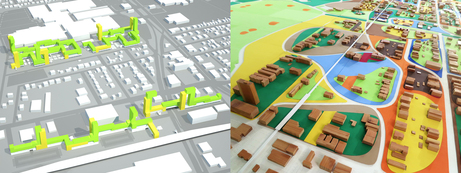
References to American suburbia typically conjure distinct images of vast, homogenous tracts of post-war residential neighborhoods, filled with white, middle-class families who left the city in search of the “American Dream” of the single-family house and lawn. Yet decentralization is neither new, nor monolithic, nor specifically American; rather, it is evident as early as the third millennium BCE outside the typical Mesopotamian city, where outlying settlement was often focused on commerce and industry. Early American suburbia was likewise often industrial, and developed as distinct municipalities, some of which were annexed by their central cities, others of which faded into oblivion, and still others of which developed into thriving economic hubs. Simultaneously, decentralization acted back upon the traditional city center, forcing a reconsideration of its own forms and qualities.
The contemporary American metropolis is therefore characterized by a wide range of decentralized urbanisms, many of which exhibit formal and spatial patterns that are much more open than in traditional settlement-what Lewis Mumford called “spatial looseness.” Because these patterns are harder to identify, understand, and instrumentalize, and because the architecture is so often banal, these conditions are easily dismissed. There is significant value in understanding them, however, as they not only are the largest and fastest growing parts of the metropolis, but also are evolving extremely quickly. They are, therefore, the primary sites of potentially innovative new architectures and new urbanisms.
This roundtable thus asks: what are the new forms of architecture and urbanism of decentralization in the American metropolis? What are the primary forces being materialized in their making (new and evolving collectives, democratic processes, free markets, new forms of mobility, others)? And what are the opportunities for the future?
Marshall Brown is a licensed architect and principal of Marshall Brown Projects. He is also an Associate Professor at the IIT College of Architecture. He is a Graham Foundation grant awardee, is currently exhibiting in the U.S. Pavilion for the 2016 Venice Architecture Biennale, and participated as a finalist in the 2012 Navy Pier Centennial Vision competition. He has new projects on view in Chicago during spring and summer 2016 at both the Arts Club of Chicago and Western Exhibitions gallery. Marshall Brown’s work has been exhibited at the Museum of Contemporary Art Detroit and Western Exhibitions in Chicago. He has served on the editorial board of the Journal of Architectural Education and has lectured at the Chicago Humanities Festival, University of Michigan, Northwestern University, the Graham Foundation, and the Arts Club of Chicago. His projects and essays have appeared in several books and journals, including Metropolis, Crain’s, Architectural Record, The New York Daily News, Art Papers, The Believer, and New Directions in Sustainable Design.
Robert Bruegmann is an historian and critic of the built environment. He received his PhD in art history from the University of Pennsylvania in 1976 and since 1979 has been at the University of Illinois at Chicago where he is currently Distinguished Professor Emeritus of Art History, Architecture and Urban Planning. Among his books are The Architects and the City: Holabird & Roche of Chicago 1880-1918 published in 1998, Sprawl: A Compact History, 2005 and The Architecture of Harry Weese, 2010. He is currently acting as editor of a book tentatively titled Art Deco Chicago about Chicago architecture, industrial design, graphic design and fashion c. 1910-50. His main areas of research are in the history of architecture, urban planning, landscape and historic preservation.
Architect Claire Cahan is Design Director at Studio Gang, an architecture and urbanism collective based in Chicago and New York. Engaging projects of various scales and typologies, Studio Gang uses design as a medium to connect people socially, experientially, and intellectually. The Studio’s research-based approach is coupled with a focus on sustainability to produce built projects that engage with pressing social, political, and ecological issues, such as the recently completed Arcus Center for Social Justice Leadership at Kalamazoo College, as well as design proposals for new typologies including Polis Station, which works with community partners to reorient police stations toward the neighborhoods they serve. Claire has led and collaborated on many of the Studio’s most pivotal projects, from the Northerly Island framework plan to a proposal for Cicero, Illinois. Developed as part of Museum of Modern Art’s 2012 exhibition Foreclosed: Rehousing the American Dream, the proposal transforms the inner-ring suburb into a thriving live-work community. A Chicago native, Claire holds a Master of Architecture from Tulane University in New Orleans. Living and learning in different urban contexts informs her understanding of the challenges facing cities today and reinforces her belief in the essential relationship between built and natural environments.
Judith K. De Jong is an architect, urbanist, and Associate Professor of Architecture at the University of Illinois at Chicago, whose work investigates the reciprocating relationships between architecture and the city, and the opportunities for design innovation in architectures and urbanisms of mass culture. Her book, New SubUrbanisms, was published in 2013. De Jong has received support from the Graham Foundation and the Great Cities Institute, where she was a 2011-2012 Faculty Scholar, and has presented her work in the U.S., Mexico City, Hong Kong, and Israel. She has written for MONU, Land Forum, CITE: The Architecture and Design Review of Houston, and The Journal of Architectural Education, among others, and her proposal “How the Strip Mall Can Save Suburbia” was a finalist in the 2010 Build A Better Burb competition. De Jong received a Master of Architecture in Urban Design from Harvard University, and a Bachelor of Architecture from the Pennsylvania State University.
Andrew Metter is currently Principal Design Consultant at Epstein in Chicago. He holds a Master of Architecture from Washington University in St. Louis. His work has received numerous design awards including Chicago Chapter AIA Distinguished Building Honor Awards. He has been the recipient of Design Awards from Progressive Architecture magazine, as well as the Architectural League of New York. His architectural works have been published in Progressive Architecture, Architecture, Architectural Record, Architect, and 150 Years of Chicago Architecture. His work has been exhibited at the Art Institute of Chicago, Museum of Science and Industry Chicago, Institute d’Architecture Francais, Paris; and the Gulbenkian Museum, Lisbon. He is an adjunct professor at IIT, and recently served as Co-Chair of the Board of Overseers of The College of Architecture at IIT. In conjunction with his IIT studio, Metter has pursued the study of leveraging existing infrastructure network systems to address the re-distribution of food, social services, and manufacturing in the City of Chicago. He is also past Chair of the Gold Medal Committee of the National AIA Committee on Design. His Serta project, which has been published widely, has received a number of national and international awards, including being named “Best of 2009” by Blair Kamin of the Chicago Tribune, and a 2010 National AIA Honor Award.
Juan Gabriel Moreno, AIA, is an award winning architect and President/Founder of JGMA (Juan Gabriel Moreno Architects). Mr. Moreno was born in Bogota, Colombia and studied architecture at California State Polytechnic University Pomona. He also lived in Florence, Italy where he studied under Superstudio founders Christiano Toraldo di Francia and Gianni Pettena. Mr. Moreno has been creating provocative works for more than 30 years. His portfolio includes having worked on projects throughout the United States and internationally. These projects represent a diverse portfolio of public and private work in typologies ranging from education, government, research, commercial, urban planning, product design and graphic design. However, in 2010 he launched JGMA with the sole purpose of transforming Chicago’s diverse communities with his architecture. Since then, JGMA has become one of the most highly acclaimed design firms in Chicago. In 2015 was recognized by Architect Magazine as one of the Top 50 Design Firms in the United States. Additionally, JGMA’s work was on display at the inaugural Chicago Architectural Biennial and Juan was invited to several of the Biennial’s panels to share his work and vision with the design community.
Mark Muenzer is the Director of Community Development for the City of Evanston. Evanston, the home of Northwestern University, is a densely populated urban suburb immediately north of Chicago along Lake Michigan. Evanston contains a vibrant and rapidly expanding downtown as well as many traditional multi-family and single-family neighborhoods adjacent to local business districts and numerous CTA and Metra transit stations. Muenzer heads a department of 35 staff members in four different department divisions – Building & Inspection Services, Planning & Zoning, Housing & Grants Administration and Transportation & Mobility. Prior to his tenure with Evanston, he was with the City of Chicago Dept of Planning & Development and managed the City’s Plan Commission and Zoning Board of Appeals and also served as the Community Development Director for the City of Countryside. He holds Bachelors in Political Science from Gannon University (PA) and a Masters in Community Planning from the University of Cincinnati. He resides in Chicago’s Ravenswood neighborhood.
Image: “How the Strip Mall Can Save Suburbia” by Judith K. De Jong and “Smooth Growth” by Marshall Brown
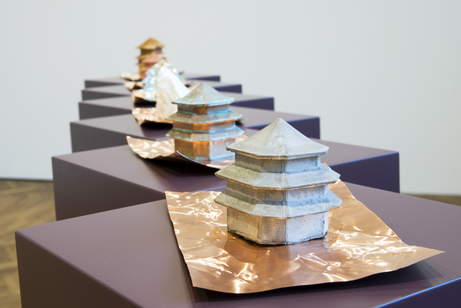
Aki Nagasaka, Project T, T for Taut, 2010
Taking its inspiration from Michael Rakowitz’s engagement with the work of an Armenian artisan and his Turkish pupil in the exhibition The Flesh Is Yours, The Bones Are Ours, this talk traces the intertwined stories of similar translations across time, space, and medium that end in Istanbul: the work of Armenian photographer Abdullah Frères during the Ottoman Period; the built environs of Turkish and German architects Sedad Eldem and Bruno Taut during the Early Republic; and the output of British and Japanese contemporary artists Victor Burgin and Aki Nagasaka. All the exhibitions, including the one on view at the Graham Foundation and the others that materialize in the lecture, perform unordinary acts of architectural history and preservation, bearing witness to the power of transversal dialogues against the absences created by historical violence.
Esra Akcan is associate professor in the Department of Architecture at Cornell University. She completed her architecture degree at the Middle East Technical University in Turkey, and her PhD and postdoctoral degrees at Columbia University. She has taught history-theory classes and architectural design studios at the University of Illinois at Chicago, Humboldt University (Berlin), Columbia University, the New School, Pratt Institute, and METU (Ankara, Turkey). Her awards and fellowships include those from the American Academy in Berlin, the University of Illinois at Chicago, the Institute for Advanced Studies in Berlin, the Graham Foundation, the Clark Institute, the Getty Research Institute, the Canadian Center for Architecture, the College Art Association, the Mellon Foundation, DAAD and KRESS/ARIT. Akcan is the author of the Architecture in Translation (Duke University Press, 2012), Turkey: Modern Architectures in History (Reaktion, 2012, with Sibel Bozdoğan), Çeviride Modern Olan (YKY, 2009), and (Land)Fill Istanbul: Twelve Scenarios for a Global City (124/3, 2004). She has guest-edited issues for Domus m (on globalization) and Centropa (on German-Turkish history), and coedited an issue for Nakhara (on writing Asian modernity). Her more than one-hundred published articles include writings on contemporary theory (critical and postcolonial theory, globalization); modern and contemporary architecture in West Asia; Ottoman architectural photography; established Euro-American architects’ engagement with the Gulf States; and the Middle Eastern diaspora in Europe.
Akcan’s scholarly work engages a geopolitically conscious global history of architecture, where her research on modern and contemporary architecture and urbanism foregrounds the intertwined histories of Europe and West Asia. Her book Architecture in Translation: Germany, Turkey and the Modern House offers a new way to understand the global movement of architecture that extends translation beyond language to visual fields. Advocating a commitment to a new culture of translatability from below and in multiple directions, it aspires toward cosmopolitan ethics and global justice. Her coauthored book Turkey: Modern Architectures in History contributes to a series that aims to produce an inclusive survey of modern world architecture, and is the first volume in any language to cover the entire twentieth century in Turkey. She is currently working on her next book on the urban renewal of Berlin's immigrant neighborhood, through which she explores a theory of open architecture.
Image: Aki Nagasaka, Project T, T for Taut, 2010.
For more information on the exhibition, The Flesh Is Yours, The Bones Are Ours, click here.
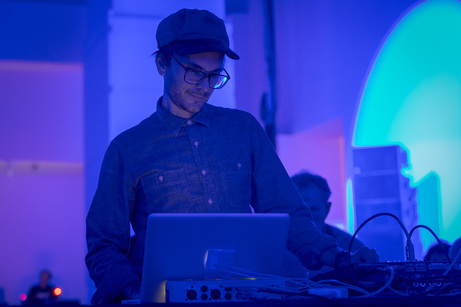
Reducing the Tempo to Zero is Ben Vida’s new, four-hour composition for four vocalists and electronics. Taking its cues from works like Stockhausen’s Sternklang, Morton Feldman’s String Quartet No. 2, and La Monte Young and Marian Zazeela’s Dream House, RtTtZ directly intervenes within the space of the gallery to oscillate between installation and performance. By employing long-form elements, Vida manipulates the listener’s experience of temporality, stripping the work of basic structural signifiers (such as a strict beginning, middle, and end), which results in an arrangement that reconsiders how the developmental arc of a musical composition might function. Prompting its audience to reinterpret their own agency (both by encouraging them to experience the piece from a number of different locations and allowing them to determine their own length of engagement with the work), RtTtZ summons multiple tempos, melodies, textures, and rhythms into a string of spatial moments, challenging a listener’s expectation, context, and perspective, while actively setting up a different kind of experiential proposal.
Given the length of this performance, audience members are invited to come and go throughout the duration of the event.
Ben Vida is an artist and composer living in New York. He has been an active member of the international experimental music community for two decades, with a long list of collaborators, projects and releases to his credit. In the mid-1990s, he cofounded the group Town and Country, and has since worked as a solo artist with labels such as PAN, Alku, Shelter Press, Future Audio Graphics, and Kranky. Vida has been the recipient of several awards, including an ISSUE Project Room Artist-in-Residency Commission; a Museu d’Art Contemporani de Barcelona Composing with Process Exclusive Works Commission; the Unsound Festival’s New Works Commission; and a Swedish Arts Committee travel grant. His recent residencies include EMS Studios, Stockholm; EMPAC, Troy, NY; and the Clocktower, NYC. His work has been performed and presented at the Guggenheim, New York; the Museum of Contemporary Art, Chicago; the Institute of Contemporary Art, London; the Kitchen, New York; Leap Gallery, Berlin; 356 Mission Road, Los Angeles; the Artist’s Institute, New York; the Sydney Opera House; Museo d’Arte Moderna di Bologna; the Borderline Festival, Athens, Greece; and the Royal Festival Hall, as part of the Meltdown Festival, in London. Vida will have his first solo exhibition at Lisa Cooley Gallery, NYC, in Spring 2016.
This performance is presented in partnership with Lampo. Founded in 1997, Lampo is a non-profit organization for experimental music and intermedia projects.
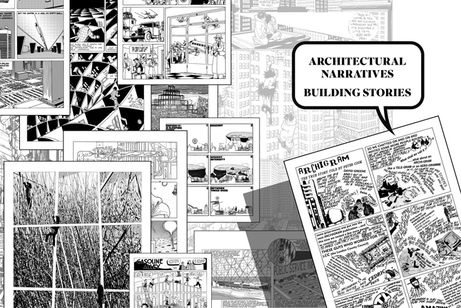
Koldo Lus Arana will discuss his recent research on the interactions between comics and architecture—both from a historical perspective and exploring current overlaps. Arana will explore the work of contemporary architects such as Jimenez Lai, Willem Jan Neutelings and many others who use comics and cartoons within their work, to the presence of architecture in comics such as those created by Chris Ware or François Schuiten.
Koldo Lus Arana is an architect, illustrator and architecture scholar. He earned a Master in Design Studies from Harvard GSD in 2008, and a PhD from the University of Navarra in 2013 with the dissertation Futuropolis: Comics and the Transmediatic Construction of the City of the Future. His main lines of research deal with the interactions between architecture and media, and with architectural prospective. He currently teaches Theory and History of Architecture in the University of Zaragoza (Spain).
This lecture is presented in partnership with MAS Context. MAS Context is a quarterly journal that addresses issues that affect the urban context.
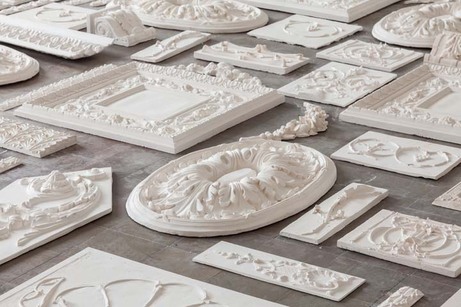
Please join us for a reception and artist talk by Michael Rakowitz to celebrate the opening of our new exhibition, The Flesh Is Yours, The Bones Are Ours.
Wednesday, May 18
6-7pm: Talk by Michael Rakowitz
7-8:30pm: Opening Reception
Michael Rakowitz is an artist living and working in Chicago. He received his BFA in sculpture from Purchase College, SUNY, and his MS in visual studies from MIT. His work has appeared in venues worldwide, including dOCUMENTA 13, PS1, MoMA, MassMOCA, Castello di Rivoli, the 16th Sydney Biennale, the 10th Istanbul Biennial, Sharjah Biennial 8, the Tirana Biennale, the National Design Triennial at the Cooper-Hewitt, and Transmediale 05. Solo exhibitions include the Tate Modern in London, Lombard Freid Gallery in New York, Trafo Gallery in Budapest, and Kunstraum Innsbruck. Rakowitz is the recipient of a 2012 Tiffany Foundation Award; a 2008 Creative Capital Grant; a Sharjah Biennial Jury Award; a 2006 NYFA Fellowship Grant in Architecture and Environmental Structures; the 2003 Dena Foundation Award; and the 2002 Design 21 Grand Prix from UNESCO. His work features in major private and public collections, including the Museum of Modern Art, New York; Neue Galerie, Kassel, Germany; the Smart Museum of Art, Chicago; the Van Abbemuseum, Eindhoven, the Netherlands; the British Museum; the Kabul National Museum, Afghanistan; and UNESCO, Paris. Rakowitz is professor of art theory and practice at Northwestern University.
Image: Michael Rakowitz, "The Flesh Is Yours, The Bones Are Ours," 2015. Installation view, Galata Greek Primary School, 14th Istanbul Biennial. Photo by Sahir Ugur Eren.
For more information on the exhibition, The Flesh Is Yours, The Bones Are Ours, click here.
Unless otherwise noted,
all events take place at:
Madlener House4 West Burton Place, Chicago
GALLERY AND BOOKSHOP HOURS
2025 Chicago Architecture Biennial
SHIFT: Architecture in Times of Radical Change
Sep 19, 2025–Feb 28, 2026
Wed–Sat, 12–5 p.m.
To make an appointment, email: bookshop@grahamfoundation.org
CONTACT
312.787.4071
info@grahamfoundation.org
Accessibility
Events are held in the ballroom on the third floor which is only accessible by stairs.The first floor of the Madlener House is accessible via an outdoor lift. Please call 312.787.4071 to make arrangements.
Copyright © 2008–2025 Graham Foundation. All rights reserved.
 PREVIOUS POSTS
PREVIOUS POSTS